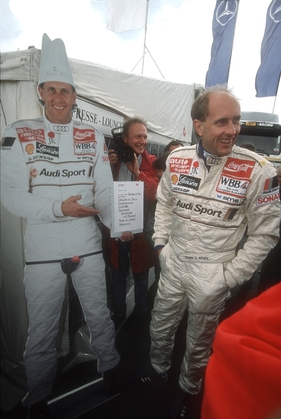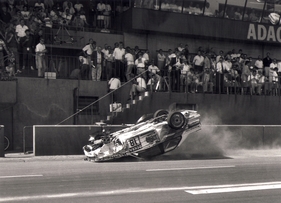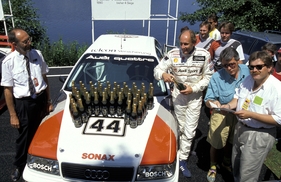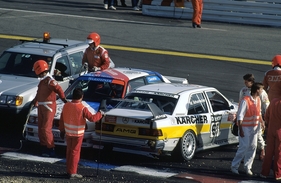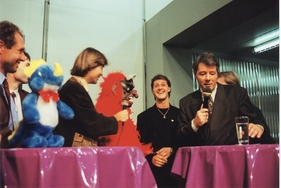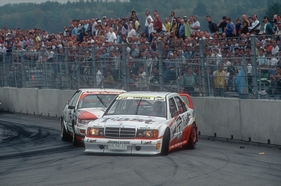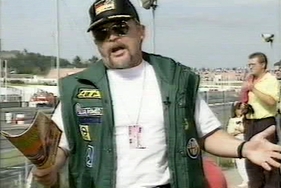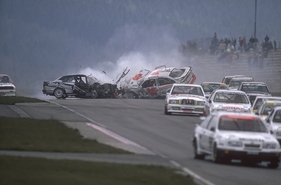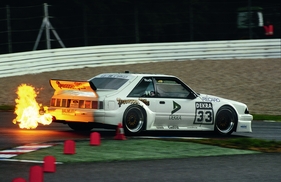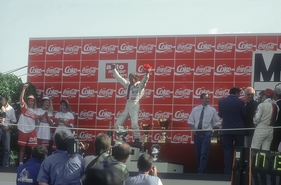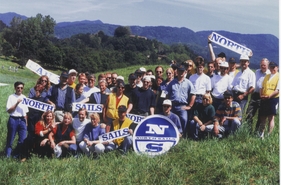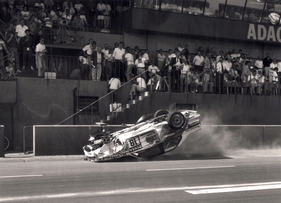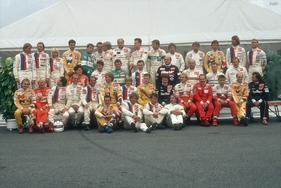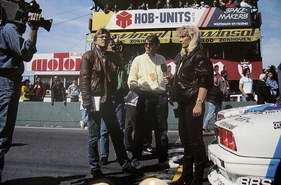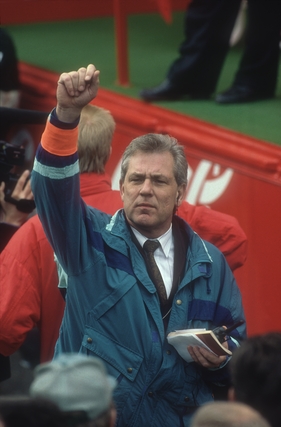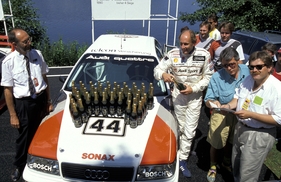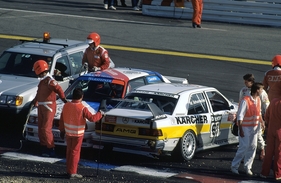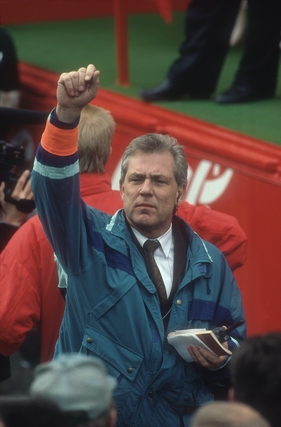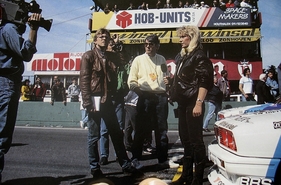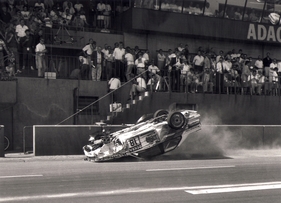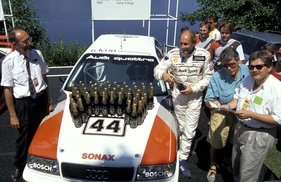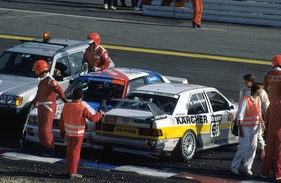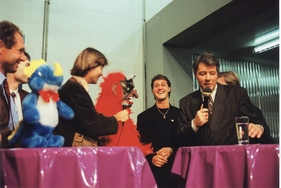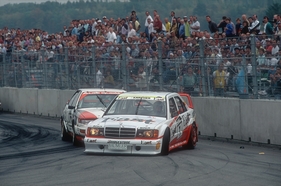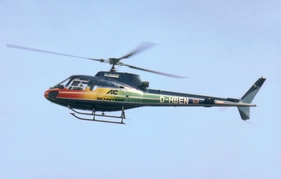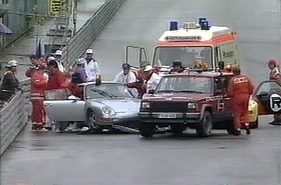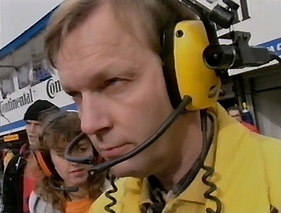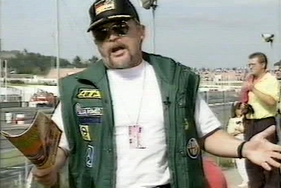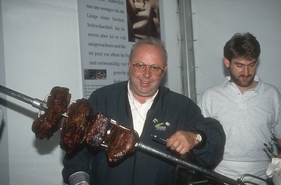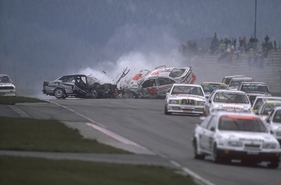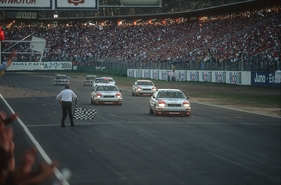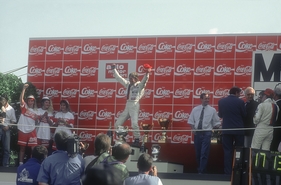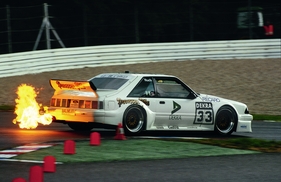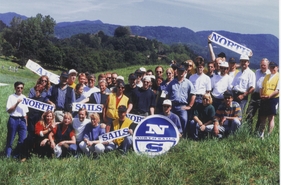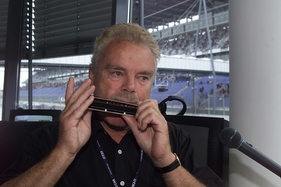The twelve years I spent with the DTM between 1984 and 1995 were some of the best times of my career as a journalist and reporter. Almost everything was just right back then; sport, fun and a good atmosphere characterized the events on and, above all, off the track. Two heats, a break for repairs, up to 40 cars and a private driver fraction that alone was as strong in numbers as the entire current starting field today. All in all, two hours of racing action, thrilling duels, shreds flying at every corner. Guys like Stuck, Cecotto, Soper, Larini, Winkelhock, Asch and Nannini dominated the scene. The prize money was paid out in cash in the evening and ITR man Jörg Weick had an uncomplicated solution for every problem.
3sat broadcast up to two hours live on Saturdays and at least three hours live on Sundays, including various support races such as Formula 3 or Porsche Cup. Depending on the number of race stoppages and restarts, Sunday broadcasts sometimes lasted four or five hours. Like in Berlin in 1994, for example, when John Winter's Opel Calibra exploded into flames after a mega-crash. We set a record for eternity with the longest DTM live broadcast of all time, exactly 5 hours and 10 minutes. Today, many feel that the TV broadcasts are loveless, lacking passion and enthusiasm.
The once famous DTM atmosphere no longer comes across the screen. I was still lucky enough to experience the wonderfully carefree DTM years as a live reporter on the front line. The countless stories that die-hard DTM fans still like to tell each other in cheerful company also come from this time of the perfect DTM world. I can think of quite a few right off the bat.
Quester's strange finish
Avus Berlin, May 1990: In the first race, Dieter Quester, in third place in a BMW M3, drifts into the outer barrier at the exit of the north bend. The BMW flips over a few times and slides across the finish line on its roof. Because the wreck is lying on the track, the race is red-flagged. Meanwhile, "Quastl" wriggles out of the pile of scrap metal, runs to race director Gerhard Gottlieb and the first thing he wants to know is: "Do I keep my third place or not?" He keeps it because 75% of the distance has been completed and the final classification is calculated by deducting one lap. After the relieving news, the indestructible Quester, who was already almost 51 at the time, was immediately faced with the next problem: "I hope my mechanics have the replacement car ready for the second race." The worry proved to be unfounded, the racing oldie climbed into the Zakspeed reserve BMW during the 10-minute break and actually drove from the back of the 30-strong field to ninth place and even into the points again.
The expensive horsepower bet with Audi
Mainz Finthen, May 1990: Audi drives its first DTM season with the V8 quattro. Hans-Joachim Stuck had easily won both races on the Avus 14 days earlier and was dangerously close to the top of the standings. There is a huge outcry from the competition, who suspect that the basic weight classification is too low. This is done according to a handicap regulation that requires the manufacturers to disclose the horsepower data, among other things. The rule of thumb is: the larger the displacement and the more power, the higher the classification weight of the DTM car in question. There is nothing to hide when it comes to the 3.6 liter displacement of the V8 quattro, but there is when it comes to power. The Ingolstadt team announced 400 hp at the start of the season, making a base weight of 1220 kg. So far, so good.
Not only the competitors BMW, Mercedes and Opel, but also "auto motor und sport" colleague Norbert Haug and I as a 3sat/ZDF commentator suspect that Audi is understating the horsepower. We suspect at least 430 hp and are quite blunt about this opinion in our work. Herwart Kreiner, Head of Sport at Ingolstadt, is outraged. Because as a result of the clamor, the agenda item "Reclassification of the Audi V8 quattro" is already up for discussion at the next meeting of the ONS sports commission. The base weight is initially increased to 1300 kg, but a compromise is later agreed upon, which is 1250 kg.
Audi Board Member for Technology Jürgen Stockmar tries to explain to Haug and me with a loyal look that we are on the wrong track with our suspicions. Nevertheless, we stick to our opinion, whereupon Stockmar offers us a rather one-sided bet: For every horsepower that the V8 engine is under the 430 horses we suspected, Norbert and I should each hand over a bottle of good champagne at the Norisring. Handed over after the race at the Dutzenteich. The performance level of Mainz is agreed as proof. We accept.
Two weeks later, disaster struck in the form of a performance diagram, which Kreiner and Stockmar triumphantly held up to us in Wunstorf. The V8 all-wheel-drive car further ahead is certified as having just 406 hp. We are shocked. Suddenly Norbert and I realize that the fun will cost each of us 24 bottles of champagne. Not a bottle of booze, mind you, but a standard premium brand. There's nothing to doubt, the diagram is a diagram, and Kreiner and Stockmar are generally considered men of honor.
At the beginning of July, we arrive at the Norisring with 48 bottles of "Lanson Brut", as befits decent losers. Stuck's Audi with the famous starting number 44 is brought into position at the Dutzenteich, the fine drink draped on the hood for the handover. Kreiner smiles, Stuck laughs out loud and pops a cork as a test. There's no denying it, Norbert and I are the fools. It's no consolation when Kreiner admits in passing that "we drove here on the Noris with 415 hp".
"He who has the damage doesn't need to worry about the ridicule" - the old adage virtually haunted us during the next races. The technicians from both the BMW and Mercedes camps smiled pityingly at us for our credulity. And when three Audi V8s won both races at the memorable DTM finale in Hockenheim and Stuck's double victory meant that the title went to Ingolstadt, the cards seemed to be finally dealt. "They've been taking the piss out of us all year and have only ever driven as fast as they had to," lamented frustrated Mercedes top driver Klaus Ludwig, who was clearly distanced in the final race. Estimates of the actual power output fluctuated between 450 and 500 hp at the finale.
When years later - Audi had long since left the DTM in a row - former Ingolstadt mechanics openly attested to the 1990 V8 engine's performance of around 500 hp, it finally became clear that we had delivered a few too many bottles of champagne after all. I file the story away under the "jokes" section and Norbert, now the newly installed Mercedes sports boss with a clean-cut image, also concludes the case with a conciliatory wink: "If we've already fallen foul of them, they could at least have invited us to join them for a drink."
Schumi, the big bang - and what was really behind it
Hockenheim 1990, DTM final. Full house, 80,000 spectators, huge atmosphere. Johnny Cecotto in the Schnitzer BMW M3 is leading the standings and has a 19-point lead over Hans Stuck (Audi V8 quattro) as the number one title contender. Mercedes is fielding its new sports car star Michael Schumacher as a guest starter in the Kärcher car without any ulterior motive. On Friday, AMG manager Domingos Piedade was already having his usual banter with his buddy Cecotto: "My friend, there's no chance of your DTM title. We've brought you Schumacher, he'll just crash into your car on the first corner and that's it." So much for the fun.
And now to reality. Schumi, starting from row seven, is "surprised by the early braking point of the car in front" before the first right-hand bend, swerves to the right across the grass and sails directly into the passenger side of the Cecotto BMW. Both cars are demolished, the race is stopped, restarted and Cecotto loses the title because he has no points in the first race. Stuck becomes champion with two clear race wins.
The scandal afterwards: BMW firmly believes in a targeted Mercedes action to help Kurt Thiim or Klaus Ludwig to the title after all. "That was a firing with announcement," said the powerful BMW General Manager Karl-Heinz Kalbfell indignantly. Meanwhile, Mr. Piedade is shocked by the repercussions of his jokey entertainment on Friday. "I would never have believed that something like this would actually happen. Johnny is a good friend of mine, we joke around like that all the time." For most racing professionals, it's as clear as day: if you really want to hit a specific car in the flurry of starts, which is also significantly further ahead, it won't work in the confusion of the first corner anyway. "You're guaranteed to hit the wrong car," says BMW team colleague Altfrid Heger. Cecotto never forgave Schumacher for this story. And some BMW people are still firmly convinced today that it was intentional at the time.
At least some BMW brand colleagues took it with a sense of humor: at the Essen Motor Show of the same year, Altfrid Heger, Kris Nissen, Harald Grohs, Armin Hahne and Annette Meeuvissen stormed the stage at the Mercedes stand during an interview round with Schumi and Jochen Mass. Following the cheerful BMW delegation was the Essen celebrity host "Purzel" (real name of the Ruhrpott original: Detlef Prycibilla) in a terrifying devil's costume. With the battle cry "Revenge for Hockenheim, revenge for Cecotto", the fiery red Satan pounces on the baffled Schumi and demands a public apology - "immediately, now and here". The audience has fun, Schumi plays along and dutifully says what they want to hear from him. This brings a conciliatory end to this highly explosive sporting story, at least at driver level.
Terminator main
Singen, premiere race 1991, huge applause in the first race. Kurt Thiim in the Mercedes leads, Frank Biela in the Audi V8 quattro follows just behind. Then Hubert Haupt, the fourth Audi works driver alongside Stuck, Biela and Jelinski and at 22 the youngest in the field, makes a memorable appearance. Due to an unscheduled pit stop, the Munich-based driver is lapped and wedges himself between leader Thiim and his pursuer Biela. What I then see on the monitor almost leaves me speechless at the reporter's desk: at the braking point for the right-hand bend after the home straight, the Audi youngster not only smashes into the rear of the car in front of him, but also elegantly pushes the baffled Mercedes man straight into the emergency exit using the gas pedal.
Result of the "heroic act": Audi team-mate Biela has a clear run to the race win, Thiim reaches the finish line in second place, just under six seconds behind. The penalty for the Rambo action is severe: Haupt is banned from race two on the spot and is later fined an additional 20,000 marks by the sports tribunal. As far as I know, this record fine still stands today, followed by Roland Asch (Norisring) and Manuel Reuter (Hockenheim) with 10,000 marks each. To Hubert Haupt's credit, however, it must also be said that, apart from the Rambo act in Singen, he is a really nice guy with the finest manners.
Helicopter emergency landings in Nirvana
Every now and then I have been able to enjoy the special luxury of individual arrival and departure in the helicopter of the TV production company WIGE. The aircraft, an Aerospatiale AS 350, serves as a relay station for the images from the cockpit cameras during live broadcasts of the DTM races. Besides pilot Bernd Kirstein, ZDF director Bernd Krämer and WIGE editor Delia Diettrich, and sometimes Walter Mertes or Wilhelm Gerner, are usually on board. Take-off and landing sites are the meadow in front of Gerner's house in Lohmar and the grounds in front of the Becker Design property in Nieder-Olm near Mainz. On the return flight from Diepholz, I am even dropped off right next to my house in Much during a quick stopover.
However, the cheerful travel companions are aware of my almost pathological fear of flying and constantly make fun of it with nasty horror stories. My only stop is pilot Kirstein, who repeatedly assures me with the patience of a saint that he has been through every conceivable emergency situation in the German army and that the helicopter is the safest aircraft of all. "There's really nothing to worry about," he reassures me before every flight, "even if we have to go down, it's completely undramatic."
On the flight to the DTM race in Singen, Kirstein suddenly says the sentence that makes me flinch and sink back into my seat: "Friends, there's a problem with the visibility, unfortunately we have to make a quick emergency landing." In the thick fog, he lands the helicopter on a stubble field about 50 km from Singen. We make our way on foot to the village inn in the next village. I fight off my fear and nausea with a few schnapps and suggest a game of poker to pass the time. It lasts about two hours, at the end of which a lot of the cash I've brought with me ends up with my colleague Delia. Then the visibility improves and after a snack we head back to the helicopter. The rest of the flight goes without a hitch, and we are eagerly awaited at our destination in Singen. Because in the paddock, the latrine slogan is already doing the rounds, according to which we "grazed a power line in the fog and landed hard on a field"....
Just one year later, on the flight back from the Norisring, the time has come again. Somewhere behind Würzburg, pilot Kirstein registers suspicious noises coming from the tail rotor area. "Something's wrong, we have to get down immediately," he tells his horrified fellow passengers. Apart from me, they are Klaus Ludwig, Walter Mertes and Bernd Krämer. Kirstein touches down gently on a meadow on the edge of a Spessart village. A quick inspection reveals that the damage can only be repaired by service personnel. As a result, we now have to arrange our own transportation home.
Kirstein secures the helicopter and we march to the nearest and only pub to make a phone call. Fortunately, I reach my two wives in the Mercedes-Media-Mobil in Nuremberg and can explain to them where they should pick me up on the way home. Meanwhile, the Ludwig/Mertes/Krämer trio ring the local car dealer from their Sunday rest and ask for the loan of a car. The man is not enthusiastic, looks at the visitors critically and tells them that he can only spare an old Opel Commodore, if at all. To be on the safe side, the worried boss asks "if any of them can even handle a car that big".
After a lot of back and forth and depositing various security deposits, the three of them are finally able to set off in the direction of Cologne. On the A 3 freeway, they meet the car of Arno Wester and Henry Panhuis, both also on their way home from Nuremberg. As the Commodore starts to overtake, Henry exclaims in amazement: "Look, Ludwig is sitting in that clunker." Arno glances to the side and only has a pitying shake of the head for his passenger. "Henry, you're already seeing ghosts. Klaus flew with the helicopter and has long since returned home."
The half-naked starter
Brno 1992: While his Czech colleague on the trackside microphone is making energetic use of his home turf, his "cold" colleague Kalli Hufstadt seizes the opportunity and rides as a guest in the back of the lead car for once. But not without ulterior motives, to which Walter Mertes, who is at the wheel, is also privy. Armed with a yellow flag, ITR man Michael Willms (also known by the nickname "the little prince") stands in the open sunroof.
During the introductory lap, Hufstadt and Mertes agree on the implementation of their evil plan: Slowly but surely, the sunroof is closed to such an extent that friend Willms can no longer get his hands inside the car. Hufstadt then opens his belt with relish and quickly pulls down the unfortunate man's pants. The tormented man has to put up with it all defencelessly, rowing his arms wildly, but is unable to stop the disaster. And so happens what will probably remain unique in DTM history: Poor Willms, embarrassed and almost exposed "down around", hands the field over to the race director for the Indy start after the finishing bend. Mertes and Hufstadt can hardly contain their laughter.
From Poldi's box of jokes
Berlin 1992: For Leopold Prince ("Poldi") of Bavaria, Dieter Quester and Hans Stuck, the Avus is traditionally the place for the worst jokes of the year. While in previous years it was usually others who suffered from the merciless mischief of the fun trio, this time Gaudi-Bursch Stuck himself becomes a victim. And it should hit him in the most sensitive spot. On Fridays, his goofy pals are already looking for a well-stocked sex store in the city. Feasting, the two return to the paddock with a huge, 30 cm long black penis complete with attachment harness.
At the entrance to the Audi press hospitality area this year, a life-size cardboard cameraman is regularly placed - a well-done gorgeous guy called Stuck with a chef's hat and menu. All available photographers are ordered to Audi for the lunch break on Saturday at one o'clock via whispered propaganda. Poldi and Quester prepare the event so covertly that Stuck remains completely unaware and is sensibly not directed to the location of the shameless exhibition until 1.05 pm. So Stucki strolls along unsuspectingly, looks around in bewilderment at the crowd and then asks the photographers: "What are you laughing so stupidly at? Only then does he realize what a huge piece has been tied around his cardboard companion and laughs along. The cheerfulness ends rather abruptly, however, when Audi sports press officer Dieter Scharnagl grumbles as the meeting breaks up and discreetly has the indecency under the sign of the four rings removed. By then, however, the pictures are already in the can.

Security chief on the wrong track
Singen 1994: Robert Streule is a busy man. Day and night, during the years of the Singen DTM race, he was concerned about optimum safety around the city circuit. For the penultimate edition of the popular city race, the head of track safety has a brand new Porsche Carrera at his disposal as a company car. The old man, who is well into his 70s, gets bright-eyed whenever he is allowed to take the 300 hp coupe for a spin around the track. But then, on Sunday during the break between the two races, Streule's drive in the rain comes to an abrupt end due to sudden aquaplaning on the guard rail. The impact is short and very violent. The result of an unsuccessful business trip: the expensive Porsche badly battered, the co-driver slightly damaged, the crash barrier bent. What's more, 3sat and ZDF are in acute time pressure due to a considerable delay in the start. The head of the ONS squadron is furious about the momentum of the local security officer and demands clarification as to how the young lady got into an official security vehicle. Incidentally, Master Streule is not seen again that day...
Arno and the hidden camera
Arno Wester is already the good spirit of the ZDF/3sat team in my day. For long stretches, the race-mad man from Düsseldorf sits next to me as a "shadow man", listening to the radio, keeping in touch with the director or calculating point constellations at lightning speed during the race. In the seven years we've spent together in the DTM, Arno sees, hears and knows everything. And when he's not sitting next to me, he sneaks through the pits, opens his eyes and ears, drags team bosses to Christa Hass in front of the microphone or drivers in time for the winner's interview.
His showpiece is the "head camera": the mini part, hidden in Arno's headset, mercilessly records everything live that the teams don't necessarily want on the screen. Such as the broken wheel carrier, the burst brake disk, the torn gearshift, the cracked seat construction or the heated discussion between team boss and driver. Wherever Arno stuck his head in, there was no more discretion. After all, it took three races to find out about the stunt with the hidden camera.
Incidentally, Mr. Wester does not like the nickname "Gitter-Arno". This came about in 1992 at the DTM race in Brno in the Czech Republic, where he had to spend a few hours in the uncomfortable custody of the Czech police for a ridiculous traffic offense.
In the new DTM, amateur racing driver Wester, now 55 years old, has also taken up his old position again and sits as a shadow man in the reporter's booth next to the commentator and pundit during ARD broadcasts. He also reports on racing events around the world as a correspondent for Motor Sport aktuell (MSa) and for the "Sport Informations Dienst" (sid).
Noble fan "Eddie"
ZDF editor Volker Tietze, often head of the 3sat live broadcast, liked to appear at the end of the program in 1994 and 1995 in the guise of the fantasy character "Eddie the Fan from Kelsterbach". Dressed as a DTM fan who loves all the manufacturers involved equally, he recalls the day's events in broad Hessian and with a great deal of humor. For quite a long time, TV viewers are firmly convinced that Eddie's performance is live. In fact, the program is often recorded during the race. The hoax is revealed when there is a technical glitch. Volker has come to a standstill during one of his passionate descriptions and breaks off. "How, too long, all right, where should I get back on?" was his question to the director. The director answers, audibly for all to hear: "From the Opel disaster". Unfortunately, they forgot to cut this part afterwards and the supposedly finished tape ends up on the channel...
Bernd Fischer and the perfect world
The owner of the company "CNC Technik Fischer" in Neustadt an der Weinstraße is a DTM fan through and through. Most DTM teams use the precision parts made by the former Alfa circuit driver. And his young protégés Sandy Grau and Bernd Mayländer would hardly have gained access to the exclusive DTM circle on their own without their patron and sponsor Bernd Fischer. The Palatinate original ("allah, trinke mer einer") is one of the nicest and most honest people in the DTM paddock. Fischer's hospitality is regarded as a hub, contact exchange and gourmet temple. He serves the best wines, the best fried potatoes, the best sausage and the best atmosphere. His traditional Palatinate DTM snack with "Weck, Wein und Worscht" for his friends at the start of the season every year in the "Eselsburg" in the Bermuda triangle of Neustadt/Mußbach/Deidesheim is also notorious. When Bernd Fischer died in a traffic accident at the end of 1994, the DTM lost an endearing splash of color.
The topless lady
Our 3sat/ZDF director Bernd Krämer has concocted and realized many a big laugh in the seven years that we have accompanied the DTM on television together. No one in the team is spared. Sometimes he fades in "Geier-Wally" instead of Walter Mertes in the TV picture, sometimes Leopold Prince of Bavaria is called "Prince Dreopold". Because Bernd is aware of my weakness and how disturbed I can get during a live report, he once organized a lady in Hockenheim to appear bare-breasted in the reporter's booth without any warning and sit on my lap without saying a word. The director gleefully waits with the OB van crew for my reaction, which can be observed via the mini-camera in the booth.
However, when the brave girl has already set off, Bernd K.'s anticipation suddenly fades. Because the control camera suddenly shows a third person in the cabin, apart from me and Arno Wester, who nobody expects to see that day. Our ZDF sports director Karl Senne has sneaked into the reporter's cabin without prior notice to watch the race from here. Bernd K. reacts quickly: he sends a man over the radio at breakneck speed to stop the lady and thus prevent the impending drama. Madame M. is literally dragged away from the cabin door at the last second. Bernd K. is really annoyed about the failed action, because the arrangement naturally has its price. "Or do you really think," says Bernd angrily after the show, "that an appearance like that is free?".....
What got under my skin...
►►the horrific head-on collision between Armin Hahne and Klaus Ludwig at the Nürburgring in 1989 on the very first lap of the second race. I'm commentating live on my third DTM race with my ZDF colleague Bela Rethy. When the Hahne-Sierra RS 500 crashes into the Ludwig-Mercedes, which is facing against the direction of travel, at almost 200 km/h, my first thought is: neither of them survived that. I'm so shocked that I carry on commentating as if in a trance. I keep trying to give people and myself hope, pointing out the extremely high safety standards of the DTM cars, that everything might have turned out okay after all. Then, during the recovery of the drivers, the helpers put up this godforsaken cloth that always promises something bad. My co-driver Bela was so shocked that he kept saying that the race and the whole broadcast had to be stopped immediately for ethical reasons. I put the brakes on Bela as best I can, the poor guy was watching such a brutal head-on crash live for the first time, just like me.
Fortunately, everything turns out much better than it looks at first. Armin is flown to hospital with a complicated fracture to his tibia and upper arm, Klaus only has severe bruising all over his body. Bela and I are infinitely relieved - and there's also a race plus broadcast after the restart.
►►Hans Stuck's first DTM title win for Audi in the packed Hockenheim Motodrom in 1990. This exuberant, cheerful atmosphere in the stands - simply magnificent, unforgettable.
►►The unwanted night practice session of the first DTM appearance in Singen in 1991. Because the track was finished late, the first Friday practice session ran into the dark. Glowing brake disks, fire-breathing exhaust pipes, the dance of the lights on the asphalt and the already packed grandstands - a spooky and fascinating experience for all those in attendance.
►►The 1992 Norisring victory by BMW driver Jockel Winkelhock. Seven years after his brother Manfred (+ 1985) won the 200 miles at the same venue in a Porsche 935 Turbo, Jockel literally screams his joy on the exit lap, half hanging out of the window and constantly clenching his fist. Jockel wanted and needed this victory in this particular place. I have never seen so much emotion in a racing driver. Commenting on these pictures gave me goose bumps.
►►Gerd Ruch's first DTM point in the Ford Mustang in the 1992 season at the finale in Hockenheim. When the Berlin privateer and crowd favorite finished the second race in tenth place and came back from the exit lap, everyone formed an alley to the pit lane and greeted and applauded the points win with so much genuine enthusiasm that their eyes almost got wet with emotion.
►►My last DTM broadcast for 3sat and ZDF in October 1995 in Hockenheim. The whole team suspected that this would be the last time we would be bringing the DTM to our viewers in their living rooms with this line-up. Aris Donzelli and I shared the two races, each of us commentating live for 3sat. At the end of the broadcast, the whole team said goodbye with a final picture. With the transformation into the ITC and the takeover of the racing series by the FIA, the broadcasting rights for 3sat and ZDF were also lost. And the new ZDF sports director Dieter Poschmann, not exactly a self-confessed motorsport fan, has no desire to fight for a continuation. Everyone in the team is incredibly sad because we had a damn good time together. No one who has put their heart and soul into their job can let something like this go.
►►The final farewell of the ITC (which was still a DTM in the hearts of the fans) to the German public on October 13, 1996 in Hockenheim. When my friend and long-time companion Kalli Hufstadt played the Cat Stevens song "Morning has broken" on his harmonica for the last time before the start, the 80,000 fans in the Motodrom fell into a depressing silence. Many a mechanic howls unrestrainedly on the starting grid, others discreetly put on their sunglasses or look away. And then this great, great audience. The ovations, the noise, the cheering from the start to the finish. The whole thing twice for 15 laps. And in the end, they all go home quiet and sad because they know what they have lost.
►►The farewell party of the DTM/ITC with the dissolution of the ITR in December 1996, Stuttgart, Maritim Hotel. Speeches by ITR President Hans-Werner Aufrecht, the sports directors Wolfgang-Peter Flohr (Opel), Giorgio Pianta (Alfa Romeo) and Norbert Haug (Mercedes). A long, emotional night with many memories and plenty of tears.
This story is taken from the first volume of the successful book series "Hallo Fahrerlager" by Rainer Braun. Further information can be found on the series' website www.hallo-fahrerlager.de .


